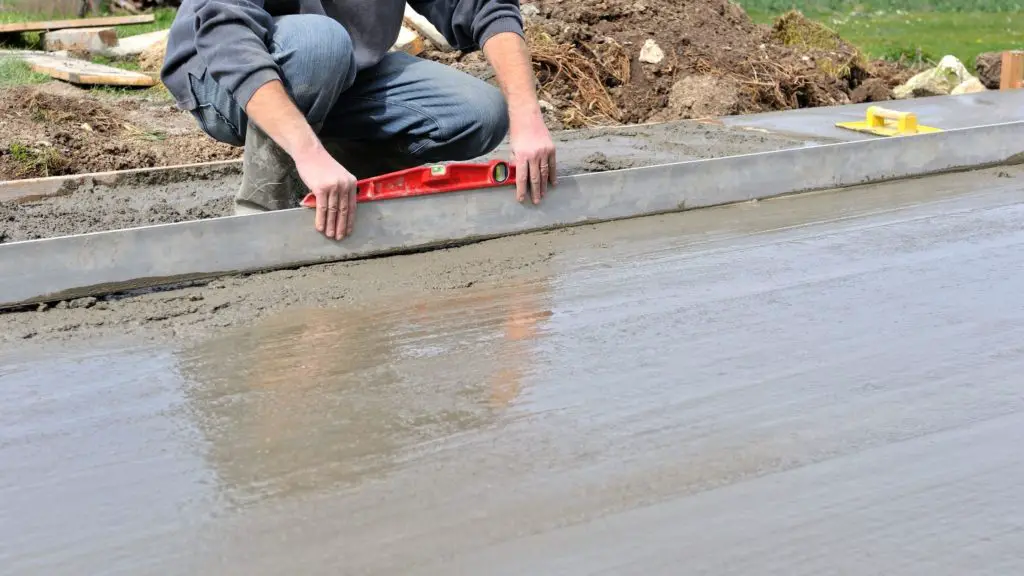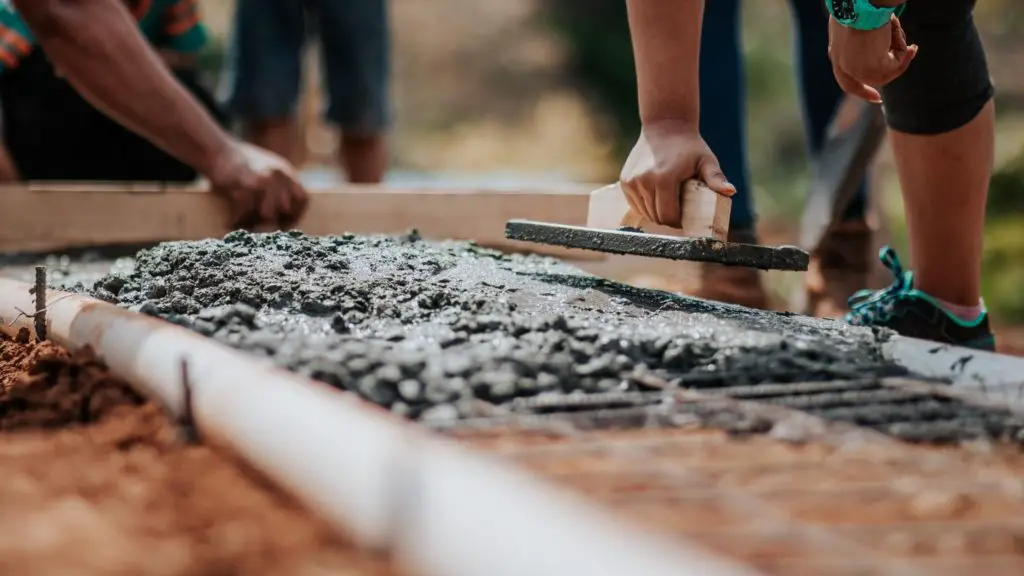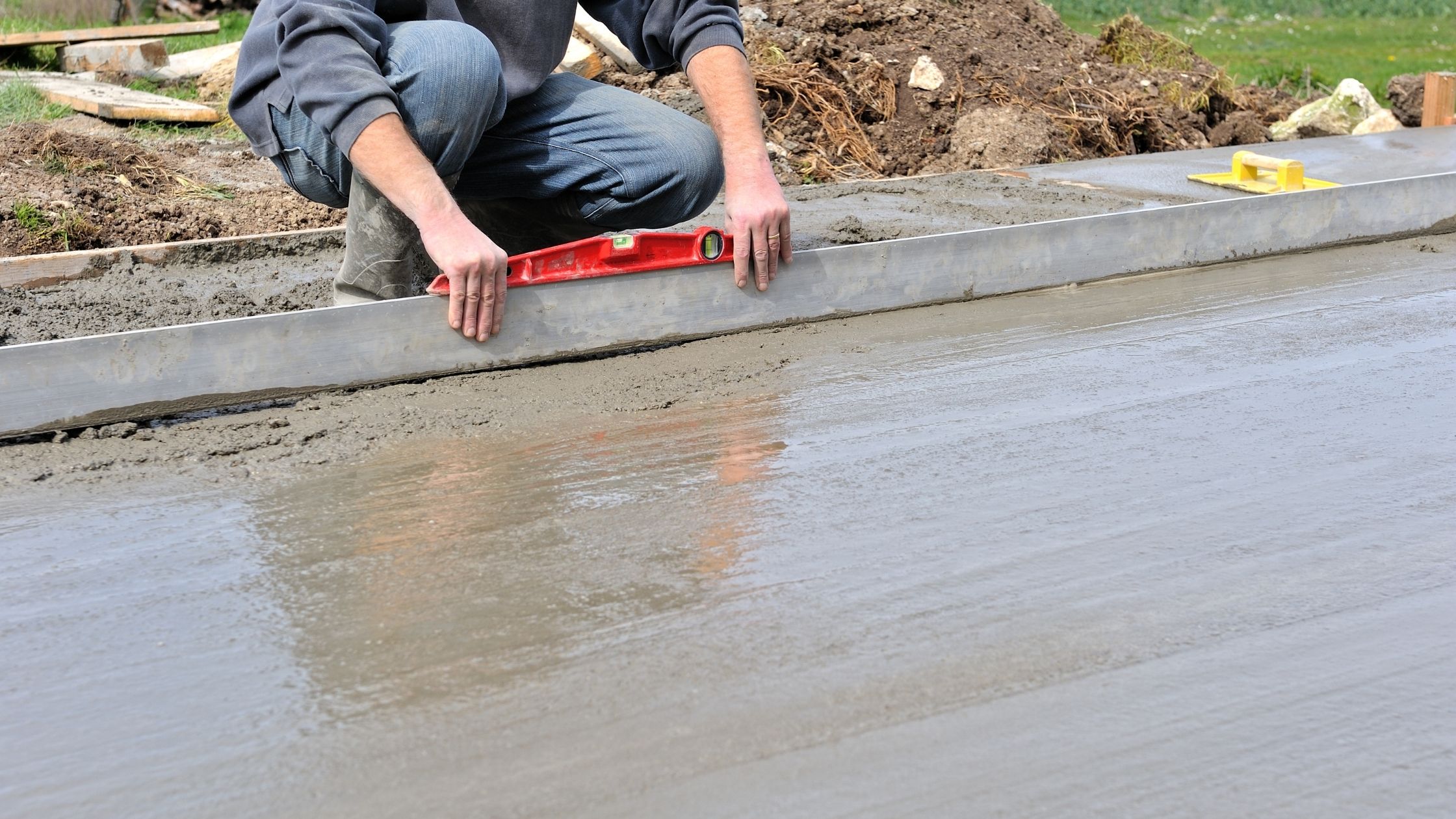Are you considering laying a patio for a shed or walkway that you’ve always wanted to make your outdoor space more practical and reduce the amount of mowing required in your backyard?
Inexpensive, versatile and easy to pour, concrete will last you for many years and is low maintenance. But can you pour a concrete slab over grass? As with any project, there are pros and cons to consider before starting work.
In this article we explain:
- The reasons not to pour a concrete slab over grass without preparing it first.
- How to prepare your grass so you can pour concrete over it.
- The best bases for concrete.
- What type of concrete will work best on grass?
- How much it costs to turn grass into concrete.
- The steps required to make a concrete slab.
- When is it acceptable to pour concrete over grass?
- How to maintain your concrete slabs.

Can you pour a concrete slab over grass?
Yes, you can directly pour concrete over existing grass, but there is some preparation that should be done first to increase the life of your slabs.
Even though concrete seems strong, time and the elements will eventually cause it to crack much sooner than expected and leave concrete remains unless you conduct the proper prep work.
Reasons not to pour a concrete slab over grass without preparing first
Drainage issues: without adequate drainage, pouring concrete straight onto soil and grass could lead to pooling moisture and erosion which causes slabs to sink and crack. Concrete is impervious, which means water can’t drain through it and your lawn will become waterlogged. This isn’t as much of an issue in the summer months as the water can evaporate, but in winter the water won’t be able to move anywhere and will become stagnant. Stagnant water smells terrible and will cause your lawn and garden to smell terrible too.
Grass regrowth: leaving roots under your slab could lead to regrowth up through cracks in the concrete. Even though grass isn’t strong enough to crack the concrete itself, it could find tiny cracks that already exist in the slab and push its way through, creating a much bigger split.
Uneven foundations: decaying grass beneath the concrete slab will cause subsidence. This means that the ground will start to sink and pull any nearby foundations with it. In severe cases, subsidence can cause walls and floors to move, which can lead to cracks and destabilize buildings.
What’s the best base for concrete?
Unlike grass, gravel and sand are not affected by temperature changes, making them good materials for a level and solid base for your concrete slab.
Here are a few benefits of using a gravel base:
Creates a level surface: grass and soil create an uneven surface, so adding a layer of gravel will create an even foundation to pour your concrete onto.
Provides sufficient drainage: a gravel base is made up of crushed stone which allows water to drain through the gaps. Drainage is important in gardens to prevent your lawn and flowerbeds from becoming waterlogged. Pricking the lawn with 2-3cm holes around your concrete slabs will help improve garden drainage.
Reduce the chances of settlement cracks: concrete is prone to cracking after long periods of time, which is caused by movement in the ground and foundations. Adding a gravel base will not only reduce the chances of this happening but also increase its longevity.
The main benefits of using sand as a base for your concrete are:
It’s affordable: sand is an inexpensive material that is widely used in construction. The more you buy, the lower the cost. Ask neighbors, family members or friends whether they need any sand before buying yours and you can bulk buy and both save some money.
Durability: sand is made up of decomposed rock, corals and shells that will not corrode or deteriorate over time.
Allows water to seep through: sand is made up of particles that are loosely spaced which means water can move through and drain quickly.

What type of concrete will work best on grass?
Quick-drying concrete (one that dries within 24 hours) is the most suitable type of concrete to use over grass. Choose a concrete that only needs mixing with water, rather than one that requires lots of steps to achieve the right consistency. Whilst lower quality concrete costs less, spending a bit more on high-quality concrete will ensure you have a good mix of water, rocks, sand and concrete that will last longer.
Good brands of concrete include Holcim, CEMEX and CRH America, or get in touch with a concrete contractor.
How much does it cost to turn grass into concrete?
There are lots of factors involved with creating concrete slabs and the total price will depend on the size of your project.
Consider the price of materials, labor and any waste removal services that you might need. These factors will depend on your requirements. Concrete is a cheaper alternative to other patio materials such as paving stones.

How to prepare your grass for concrete
Follow the steps below to lay the perfect concrete slab over your grass.
- Start by removing the top layer of soil from your grass with a shovel.
- Dig out any debris, weeds, trees or roots where you intend to lay the concrete slab.
- Create a level foundation by adding sand or gravel.
- Add a layer of plastic sheeting such as polyurethane to prevent moisture from rising up and touching your concrete slab.
- Add a wooden box barrier to ensure the concrete holds its shape when you pour it.
- Protect the lawn around your box barrier from any concrete spillage with more plastic sheets.
- Install a reinforcing bar (a mesh of steel wires known as rebar) to give the concrete something to bind to and prevent it from cracking.
- Mix the concrete either by hand or using a mixer. If you’re mixing by hand, make sure you use a large mixing board that is placed on a level part of the ground and check that the ratio of sand, gravel and water is correct. Slowly mix the correct amount of water with your dry concrete.
- Carefully pour your cement mixture into your wooden barrier until it is at least four inches deep and covers the rebar.
- Leave the concrete slab to set for at least 24 hours before putting anything on top of it. Once it’s completely dry, remove your barrier and the plastic sheeting.
When is it acceptable to pour concrete over grass?
If you need to complete your patio area or base for a shed quickly, you may want to just crack on and lay your concrete slab over grass. There are no guarantees that you won’t have issues in the future from laying slabs straight over grass, but the following tips and reasons may help you get away with it.
- Pour thicker concrete, at least six inches. By adding a thick layer of concrete, it will take grass much longer to work its way up and cause any issues.
- Maintain the concrete by filling any cracks that appear regularly.
If you’re looking for a temporary solution and intend on removing the concrete in the near future, pouring it straight onto grass shouldn’t cause you any issues.
How to maintain your concrete slabs
Unfortunately, rainwater isn’t enough to keep your slabs looking good. Use a mild detergent once or twice a year to get rid of grease and grime that builds up on concrete. Rinse with a power washer and broom to keep staining and discoloration at bay.
Regularly inspect your slabs to check for any smaller cracks that you can repair with a concrete repair product before they get too large and cause issues such as moving.
Using a sealant on the surface of your slabs will provide UV protection and act as a barrier against surface damage. Sealant is also used to repel water, stopping your concrete from getting waterlogged during the rainy seasons.
Avoid using harsh chemicals that could corrode your slabs, particularly those that contain ammonium nitrates and sulfates because they are known to attack concrete and break it down.
Manage plant regrowth by trimming any roots that grow up beneath the concrete regularly to prevent them from causing any significant damage to your slabs.

Enjoy crack-free concrete slabs
As a busy homeowner, it can be tempting to try and cut corners on renovation work. However, pouring concrete straight onto grass without doing the proper preparation work first will only cause you more issues in the long term.
Use the advice in this article to prepare your grass correctly and enjoy level, smooth and crack-free slabs in your backyard for many years, without needing to pay out for expensive and time-consuming maintenance.

